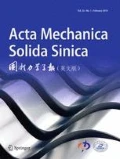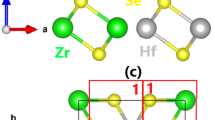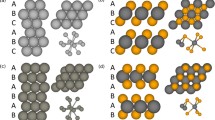Abstract
Molecular dynamics simulations are performed to investigate the misfit strain-induced buckling of the transition-metal dichalcogenide (TMD) lateral heterostructures, denoted by the seamless epitaxial growth of different TMDs along the in-plane direction. The Stillinger–Weber potential is utilized to describe both the interaction for each TMD and the coupling between different TMDs, i.e., \(\hbox {MX}_{2}\) (with \(\mathrm{M}=\hbox {Mo}\), W and \(\mathrm{X}=\hbox {S}\), Se, Te). It is found that the misfit strain can induce strong buckling of the freestanding TMD lateral heterostructures of large area, resulting from the TMDs’ atomic-thick nature. The buckling phenomenon occurs in a variety of TMD lateral heterostructures of different compositions and in various patterns. Our findings raise a fundamental mechanical challenge for the structural stability of the freestanding TMD lateral heterostructures.








Similar content being viewed by others
References
Huang C, Wu S, Sanchez AM, Peters JJ, Beanland R, Ross JS. Lateral heterojunctions within monolayer MoSe\(_{2}\)–\(\text{ WSe }_{2}\) semiconductors. Nat Mater. 2014;13(12):1096.
Gong Y, Lin J, Wang X, Shi G, Lei S, Lin Z. Vertical and in-plane heterostructures from WS 2/MoS 2 monolayers. Nat Mater. 2014;13(12):1135.
Zhang X-Q, Lin C-H, Tseng Y-W, Huang K-H, Lee Y-H. Synthesis of lateral heterostructures of semiconducting atomic layers. Nano Lett. 2014;15(1):410–5.
Duan X, Wang C, Shaw JC, Cheng R, Chen Y, Li H. Lateral epitaxial growth of two-dimensional layered semiconductor heterojunctions. Nat Nanotechnol. 2014;9(12):1024.
Chen K, Wan X, Wen J, Xie W, Kang Z, Zeng X. Electronic properties of MoS2–WS2 heterostructures synthesized with two-step lateral epitaxial strategy. Acs Nano. 2015;9(10):9868–76.
Chen K, Wan X, Xie W, Wen J, Kang Z, Zeng X. Lateral built-in potential of monolayer MoS2–WS2-in-plane heterostructures by a shortcut growth strategy. Adv Mater. 2015;27(41):6431–7.
Gong Y, Lei S, Ye G, Li B, He Y, Keyshar K. Two-step growth of two-dimensional WSe2/MoSe2 heterostructures. Nano Lett. 2015;15(9):6135–41.
Chen J, Zhou W, Tang W, Tian B, Zhao X, Xu H. Lateral epitaxy of atomically sharp WSe2/WS2 heterojunctions on silicon dioxide substrates. Chem Mater. 2016;28(20):7194–7.
Ling X, Lin Y, Ma Q, Wang Z, Song Y, Yu L. Parallel stitching of 2D materials. Adv Mater. 2016;28(12):2322–9.
Liu B, Ma Y, Zhang A, Chen L, Abbas AN, Liu Y. High-performance WSe2 field-effect transistors via controlled formation of in-plane heterojunctions. ACS Nano. 2016;10(5):5153–60.
Son Y, Li M-Y, Cheng C-C, Wei K-H, Liu P, Wang QH. Observation of switchable photoresponse of a monolayer WSe2–MoS2 lateral heterostructure via photocurrent spectral atomic force microscopic imaging. Nano Lett. 2016;16(6):3571–7.
Chen X, Qiu Y, Yang H, Liu G, Zheng W, Feng W. In-plane mosaic potential growth of large-area 2D layered semiconductors MoS2–MoSe2 lateral heterostructures and photodetector application. ACS Appl Mater Interfaces. 2017;9(2):1684–91.
Li MY, Pu J, Huang JK, Miyauchi Y, Matsuda K, Takenobu T. Self-aligned and scalable growth of monolayer WSe2–MoS2 lateral heterojunctions. Adv Funct Mater. 2018;28(17):1706860.
Sahoo PK, Memaran S, Xin Y, Balicas L, Gutiérrez HR. One-pot growth of two-dimensional lateral heterostructures via sequential edge-epitaxy. Nature. 2018;553(7686):63.
Li M-Y, Shi Y, Cheng C-C, Lu L-S, Lin Y-C, Tang H-L. Epitaxial growth of a monolayer WSe2–MoS2 lateral pn junction with an atomically sharp interface. Science. 2015;349(6247):524–8.
Zhang Z, Chen P, Duan X, Zang K, Luo J, Duan X. Robust epitaxial growth of two-dimensional heterostructures, multiheterostructures, and superlattices. Science. 2017;357:eaan6814.
Bogaert K, Liu S, Chesin J, Titow D, Gradečak S, Garaj S. Diffusion-mediated synthesis of MoS2/WS2 lateral heterostructures. Nano Lett. 2016;16(8):5129–34.
Li H, Wu X, Liu H, Zheng B, Zhang Q, Zhu X. Composition-modulated two-dimensional semiconductor lateral heterostructures via layer-selected atomic substitution. ACS Nano. 2016;11(1):961–7.
Mahjouri-Samani M, Lin M-W, Wang K, Lupini AR, Lee J, Basile L. Patterned arrays of lateral heterojunctions within monolayer two-dimensional semiconductors. Nat Commun. 2015;6:7749.
Li H, Li P, Huang J-K, Li M-Y, Yang C-W, Shi Y. Laterally stitched heterostructures of transition metal dichalcogenide: chemical vapor deposition growth on lithographically patterned area. ACS Nano. 2016;10(11):10516–23.
Ullah F, Sim Y, Le CT, Seong M-J, Jang JI, Rhim SH. Growth and simultaneous valleys manipulation of two-dimensional MoSe2–WSe2 lateral heterostructure. ACS Nano. 2017;11(9):8822–9.
Kobayashi Y, Mori S, Maniwa Y, Miyata Y. Bandgap-tunable lateral and vertical heterostructures based on monolayer Mo1-xWxS2 alloys. Nano Res. 2015;8(10):3261–71.
Zhang W, Li X, Jiang T, Song J, Lin Y, Zhu L. CVD synthesis of Mo (1- x) W x S 2 and MoS 2 (1- x) Se 2x alloy monolayers aimed at tuning the bandgap of molybdenum disulfide. Nanoscale. 2015;7(32):13554–60.
Yoshida S, Kobayashi Y, Sakurada R, Mori S, Miyata Y, Mogi H. Microscopic basis for the band engineering of Mo 1- x W x S 2-based heterojunction. Sci Rep. 2015;5:14808.
Duan X, Wang C, Fan Z, Hao G, Kou L, Halim U. Synthesis of WS2 x Se2-2 x alloy nanosheets with composition-tunable electronic properties. Nano Lett. 2015;16(1):264–9.
Liu X, Wu J, Yu W, Chen L, Huang Z, Jiang H. Monolayer WxMo1- xS2 grown by atmospheric pressure chemical vapor deposition: bandgap engineering and field effect transistors. Adv Funct Mater. 2017;27(13):1606469.
Aslan OB, Datye IM, Mleczko MJ, Sze Cheung K, Krylyuk S, Bruma A. Probing the optical properties and strain-tuning of ultrathin Mo1-x W x Te2. Nano Lett. 2018;18(4):2485–91.
Apte A, Kochat V, Rajak P, Krishnamoorthy A, Manimunda P, Hachtel JA. Structural phase transformation in strained monolayer MoWSe2 alloy. ACS Nano. 2018;12(4):3468–76.
Li H, Zhang Q, Duan X, Wu X, Fan X, Zhu X. Lateral growth of composition graded atomic layer MoS2 (1-x) Se2 x nanosheets. J Am Chem Soc. 2015;137(16):5284–7.
Zheng S, Sun L, Yin T, Dubrovkin AM, Liu F, Liu Z. Monolayers of WxMo1- xS2 alloy heterostructure with in-plane composition variations. Appl Phys Lett. 2015;106(6):063113.
Wu X, Li H, Liu H, Zhuang X, Wang X, Fan X. Spatially composition-modulated two-dimensional WS 2x Se 2 (1- x) nanosheets. Nanoscale. 2017;9(14):4707–12.
Li Z, Zheng J, Zhang Y, Zheng C, Woon W-Y, Chuang M-C. Synthesis of ultrathin composition graded doped lateral WSe2/WS2 heterostructures. ACS Appl Mater Interfaces. 2017;9(39):34204–12.
Xie S, Tu L, Han Y, Huang L, Kang K, Lao KU. Coherent, atomically thin transition-metal dichalcogenide superlattices with engineered strain. Science. 2018;359(6380):1131–6.
Zhang C, Li M-Y, Tersoff J, Han Y, Su Y, Li L-J. Strain distributions and their influence on electronic structures of WSe 2-MoS 2 laterally strained heterojunctions. Nat Nanotechnol. 2018;13(2):152.
Alred JM, Zhang Z, Hu Z, Yakobson BI. Interface-induced warping in hybrid two-dimensional materials. Nano Res. 2015;8(6):2015.
Shi Z, Zhang Q, Schwingenschlögl U. Alloying as a route to monolayer transition metal dichalcogenides with improved optoelectronic performance: Mo (S1-x Se x) 2 and Mo1-y W y S2. ACS Appl Energy Mater. 2018;1(5):2208–14.
Wei W, Dai Y, Niu C, Huang B. Controlling the electronic structures and properties of in-plane transition-metal dichalcogenides quantum wells. Sci Rep. 2015;5:17578.
Wei W, Dai Y, Sun Q, Yin N, Han S, Huang B. Electronic structures of in-plane two-dimensional transition-metal dichalcogenide heterostructures. Phys Chem Chem Phys. 2015;17(43):29380–6.
Guo Y, Robertson J. Band engineering in transition metal dichalcogenides: stacked versus lateral heterostructures. Appl Phys Lett. 2016;108(23):233104.
Wei W, Dai Y, Huang B. In-plane interfacing effects of two-dimensional transition-metal dichalcogenide heterostructures. Phys Chem Chem Phys. 2016;18(23):15632–8.
Zhang J, Xie W, Zhao J, Zhang S. Band alignment of two-dimensional lateral heterostructures. 2D Mater. 2016;4(1):015038.
Wei W, Dai Y, Huang B. Straintronics in two-dimensional in-plane heterostructures of transition-metal dichalcogenides. Phys Chem Chem Phys. 2016;19(1):663–72.
Aras M, Kılıç Ç, Ciraci S. Lateral and vertical heterostructures of transition metal dichalcogenides. J Phys Chem C. 2018;122(3):1547–55.
Kang J, Sahin H, Peeters FOM. Tuning carrier confinement in the MoS2/WS2 lateral heterostructure. J Phys Chem C. 2015;119(17):9580–6.
An Y, Zhang M, Wu D, Fu Z, Wang K. The electronic transport properties of transition-metal dichalcogenide lateral heterojunctions. J Mater Chem. 2016;4(46):10962–6.
Yang Z, Pan J, Liu Q, Wu N, Hu M, Ouyang F. Electronic structures and transport properties of a MoS 2-NbS 2 nanoribbon lateral heterostructure. Phys Chem Chem Phys. 2017;19(2):1303–10.
Cao Z, Harb M, Lardhi S, Cavallo L. Impact of interfacial defects on the properties of monolayer transition metal dichalcogenide lateral heterojunctions. J Phys Chem Lett. 2017;8(7):1664–9.
Sun J, Lin N, Ren H, Tang C, Yang L, Zhao X. Gas adsorption on MoS 2/WS 2 in-plane heterojunctions and the I-V response: a first principles study. RSC Adv. 2016;6(21):17494–503.
Yang Y, Fang WH, Long R. Disparity in photoexcitation dynamics between vertical and lateral MoS2/WSe2 heterojunctions: time-domain simulation emphasizes the importance of donor-acceptor interaction and band alignment. J Phys Chem Lett. 2017;8:5771–8.
Sun Q, Dai Y, Ma Y, Yin N, Wei W, Yu L. Design of lateral heterostructure from arsenene and antimonene. 2D Mater. 2016;3(3):035017.
Jin H, Li J, Wang B, Yu Y, Wan L, Xu F. Electronics and optoelectronics of lateral heterostructures within monolayer indium monochalcogenides. J Mater Chem C. 2016;4(47):11253–60.
Leenaerts O, Vercauteren S, Schoeters B, Partoens B. System-size dependent band alignment in lateral two-dimensional heterostructures. 2D Mater. 2016;3(2):025012.
Leenaerts O, Vercauteren S, Partoens B. Band alignment of lateral two-dimensional heterostructures with a transverse dipole. Appl Phys Lett. 2017;110(18):181602.
Cheng K, Guo Y, Han N, Su Y, Zhang J, Zhao J. Lateral heterostructures of monolayer group-IV monochalcogenides: band alignment and electronic properties. J Mater Chem C. 2017;5(15):3788–95.
Sun Q, Dai Y, Niu C, Ma Y, Wei W, Yu L. Lateral topological crystalline insulator heterostructure. 2D Mater. 2017;4(2):025038.
Sun Q, Dai Y, Yin N, Yu L, Ma Y, Wei W. Two-dimensional square transition metal dichalcogenides with lateral heterostructures. Nano Res. 2017;10(11):3909–19.
Yuan J, Yu N, Wang J, Xue K-H, Miao X. Design lateral heterostructure of monolayer ZrS2 and HfS2 from first principles calculations. Appl Surf Sci. 2018;436:919–26.
Jiang J-W, Zhou Y-P. Parameterization of Stillinger–Weber potential for two-dimensional atomic crystals. Handbook of Stillinger–Weber potential parameters for two-dimensional atomic crystals. The Hague: InTech; 2017.
Jiang J-W. Parametrization of Stillinger–Weber potential based on valence force field model: application to single-layer MoS2 and black phosphorus. Nanotechnology. 2015;26(31):315706.
Nosé S. A unified formulation of the constant temperature molecular dynamics methods. J Chem Phys. 1984;81(1):511–9.
Hoover WG. Canonical dynamics: equilibrium phase-space distributions. Phys Rev A. 1985;31(3):1695.
Plimpton S. Fast parallel algorithms for short-range molecular dynamics. J Comput Phys. 1995;117(1):1–19.
Stukowski A. Visualization and analysis of atomistic simulation data with OVITO-the Open Visualization Tool. Model Simul Mater Sci Eng. 2009;18(1):015012.
Kushima A, Qian X, Zhao P, Zhang S, Li J. Ripplocations in van der Waals Layers. Nano Lett. 2015;15(2):1302–8.
Zhou Y-P, Jiang J-W. Molecular dynamics simulations for mechanical properties of borophene: parameterization of valence force field model and Stillinger–Weber potential. Sci Rep. 2017;7:45516.
Acknowledgements
The work is supported by the Recruitment Program of Global Youth Experts of China, the National Natural Science Foundation of China (NSFC) under Grant No. 11504225, and the Innovation Program of Shanghai Municipal Education Commission under Grant No. 2017-01-07-00-09-E00019.
Author information
Authors and Affiliations
Corresponding author
Appendix: Modification for LAMMPS
Appendix: Modification for LAMMPS
We point out one necessary modification for the three-body SW potential implemented in LAMMPS. More details on this modification can be found from our earlier work [65]. Overall, the modification is done in two steps.
-
1)
First, find the following line in the pair sw.cpp source file,
delcs = cs - paramijk->costheta;
-
2)
Second, insert the following new lines after the above line,
if(fabs(delcs) <= 0.25)
{
delcs = delcs; }
else if(fabs(delcs) < 0.35)
{
delcs = delcs * (0.5+0.5*sin(3.142*(delcs-0.25)/(0.35-0.25)+0.5*3.142));
}
else
{
delcs = 0.0;
}
Then, recompile the LAMMPS package. The recompiled LAMMPS executable file can be used to simulate materials with inequivalent angles around each atom (like TMDs in the present work) using the SW potential. This modification does not affect other simulations with LAMMPS.
Rights and permissions
About this article
Cite this article
Jiang, JW. Misfit Strain-Induced Buckling for Transition-Metal Dichalcogenide Lateral Heterostructures: A Molecular Dynamics Study. Acta Mech. Solida Sin. 32, 17–28 (2019). https://doi.org/10.1007/s10338-018-0049-z
Received:
Revised:
Accepted:
Published:
Issue Date:
DOI: https://doi.org/10.1007/s10338-018-0049-z




